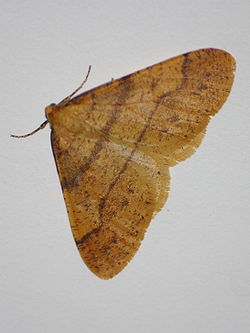Agriopis aurantiaria
| Agriopis aurantiaria | |
|---|---|

| |
| Scientific classification | |
| Kingdom: | |
| Phylum: | |
| Class: | |
| Order: | |
| Family: | |
| Tribe: | |
| Genus: | |
| Species: | A. aurantiaria
|
| Binomial name | |
| Agriopis aurantiaria (Hübner, 1799)
| |
Agriopis aurantiaria, the scarce umber, is a moth of the Geometridae family. It is found throughout Europe.

The wingspan is 27–35 mm. There is a strong sexual dimorphism between the two sexes.
The males have normal developed wings. The forewings are dark golden-yellow or orange-yellow to light brown and dusted with many black scales. There are three brown-grey transverse bands the outermost broken. Sometimes there are large black patches in the postdiscal area. The hind wings have the basic colour as the forewings, but are however always paler with two thin, dark lines. The antennae are double saw-combed.
The flightless females have almost entirely vestigial wings, a clumsy body, tapering at the end of body shape and are a grey-brown colour. The stub wings have a grey color with two black crosses. Adults are on wing from October to November.
The larvae feed on various deciduous trees, includingBetula, Quercus robur, Sorbus aucuparia, Rosa and Prunus padus.
Subspecies
- Agriopis aurantiaria aurantiaria
- Agriopis aurantiaria cleui
- Agriopis aurantiaria lariciaria
References
- Waring, P. en M. Townsend (2006) Nachtvlinders, veldgids met alle in Nederland en België voorkomende soorten, Baarn: Tirion.
External links
